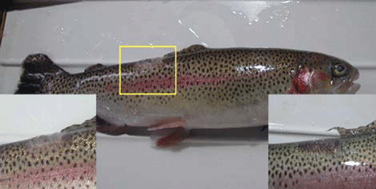The applicability of a novel procedure for the disinfection of microbiologically polluted waters from fish-farming ponds, based on the combined action of visible light (including sunlight) and porphyrin-type photosensitising agents, has been investigated using (a) cell cultures of a Gram-positive bacterium (meticillin-resistant Staphylococcus aureus), a Gram-negative bacterium (Escherichia coli) and a fungal pathogen (Saprolegnia spp.); (b) pilot aquaculture plants involving either spontaneously or artificially Saprolegnia-infected rainbow trout (Oncorhynchus mykiss). The results obtained by using two cationic porphyrins, namely a tetra-substituted N-methyl-pyridyl-porphine (C1) and its analogue where one N-methyl group had been replaced by a N-tetradecyl chain (C14), and low intensity visible light irradiation showed an extensive (up to 6–7 log) decrease in the bacterial/fungal population after short incubation and irradiation times in the presence of micromolar photosensitiser concentrations. Moreover, C14 showed some toxic effect also in the absence of light. Extension of these studies to the pilot plants indicated that both C1 + light and C14 can prevent Saprolegnia infections or promote the cure of saprolegniasis in infected trout by treatments with submicromolar porphyrin doses. The procedure appears to be of low cost and to have a low environmental impact.

You have access to this article
 Please wait while we load your content...
Something went wrong. Try again?
Please wait while we load your content...
Something went wrong. Try again?


 Please wait while we load your content...
Please wait while we load your content...